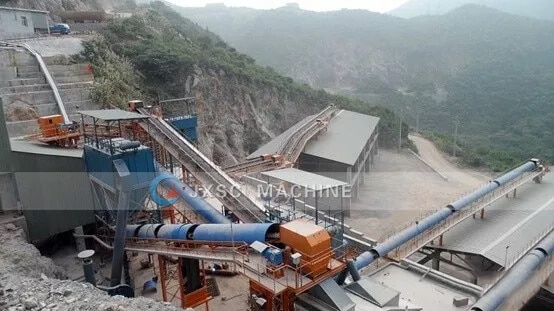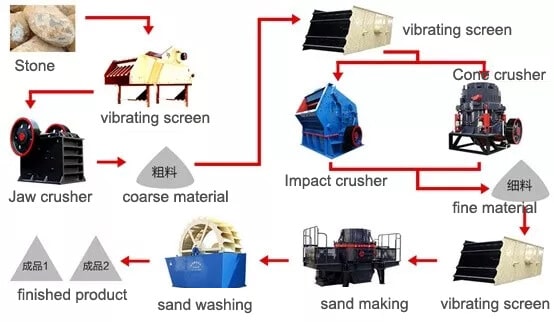Sand Manufacturing Plant Layout and Considerations
Manufactured sand is one of the main raw materials for concrete, mortar and corresponding products. The traditional aggregate processing line is generally small in scale and lacks long-term planning and design, which cannot meet the needs of current development. Therefore, a new type of sand manufacturing plant came into being, and standardized design is imperative. Here are the considerations about sand manufacturing plant design.

1 Sand manufacturing plant layout
The design of the sand production line involves mines, general plans, processes, electrical automation, civil works, water supply and drainage, HVAC, environmental protection, budget estimates and technical economy.
1.1 Determine a reasonable stone crush location
Combined with the quality of the mines of existing mines or newly purchased mines, it is estimated that the planned mining period, such as 15 to 20 years. Consideration should also be given to arranging sand and gravel plants near the quarry in order to reduce the transport distance of raw materials. When the quarry and the main users are far apart, it is advisable to arrange the coarse crush in the quarry, and the coarsely broken intermediate material is sent to the main plant area through the conveying equipment for further processing and manufacturing.
1.2 Sand making plant site selection
1) The aggregate crushing plant site must avoid the blasting danger zone. The safety distance should comply with the relevant regulations. The distance from the blasting point should exceed 200m.
2) The site should be close to the existing transportation roads, water sources and power sources.
3) The site should be far away from towns or residential areas. When it is set up in towns or residential areas, it should be placed on the downwind side of the dominant wind direction and maintain the necessary protection distance.
1.3 Graphic design of sand making line
1) Meet relevant regulations or regulations for the process, transportation, fire prevention, construction, etc.
2) Under the premise of meeting the process requirements, the overall layout should be as compact as possible, save land, and at the same time leave room for equipment operation and maintenance.
3) Make full use of the existing terrain for vertical design to reduce the amount of earth and stone works, so that the broken materials can be self-flowing or semi-self-flowing.
4) The rough crushing position should be close to the feeding direction of the material yard, and the finished material yard is close to the transportation road.
5) It is necessary to avoid placing important workshops such as crushing, sieving and sand making in caves, landslides, mudslides and filling areas. If it is necessary to arrange in the above-mentioned sections, it should be fully technically demonstrated and take reliable measures.
1.4 Electrical automation
The electrical automation design should adopt advanced and reliable DCS or PLC control system with high automation level to achieve high efficiency, energy saving, stable production, optimized control, etc., and minimize the number of operators and reduce production costs.
1.5 Plant building structure
Under the premise of meeting the production requirements, the civil engineering design should be arranged in the open air as much as possible to minimize the cost of civil works. The architectural design shall strictly comply with the relevant national architectural design codes and standards, pay attention to the ventilation, heat dissipation, sound insulation and shock absorption measures of the workshop, and adopt technical measures such as fire prevention, explosion protection, waterproof and moisture proof.
1.6 Water supply and drainage and HVAC
1) Water for aggregate production line mainly considers spray dusting water, sandstone washing water, domestic water, fire water and so on. The drainage system uses rainwater and production and domestic wastewater to divert the drainage system.
2) In the heating area specified by the state, the design should consider centralized heating; the workshop that distributes waste heat in the production process, the pit that transports hot and cold materials, the underground belt corridor, and other wet and hot pits, the chlorination room of the circulating water pumping station, Ventilation pump stations, air compressor stations, etc. should be designed to ventilate to remove residual heat and harmful gases; the switches of the accident fans are set at indoor and outdoor locations for easy operation.
3) Calculate the total gas consumption of the production line according to the gas point of the compressed air and other compressed air in the production line, and take into account the coefficient of pipeline leakage, regenerative gas consumption and safety of the dryer, 1.2~1.3, design and select the compressed air station of the production line. Total design capability.
1.7 Mining extraction
In terms of mining, through the analysis of mine exploration data, formulate mine development and utilization plans, rational use of mine resources, consider re-cultivation and forestry, avoid adverse geological disasters, achieve development and utilization, protect the ecology, save resources, and be environmentally friendly.
1.8 Stone crushing technology
Process design must first determine the production scale, carry out process balance calculation, reasonably determine the process equipment capacity, operation rate, material balance calculation, and reasonably determine the storage mode and storage period of various materials.
According to the characteristics of dust in the production process, the dust removal scheme is determined, the air volume calculation is carried out, and the dust collector is reasonably selected.
Analyze the soil content, hardness and other characteristics of the ore. According to the characteristics of the region where the enterprise is located, through the comparison of the schemes, the equipment such as soil removal, crushing, screening, sand making, dust removal and transportation can be reasonably selected.
The aggregate processing design balances the electricity, water and gas used in the whole plant, and uses the system theory to make the performance matching of each part of the mechanism sandstone production line to the best, and the whole production line runs with high quality and high efficiency.

2 Environmental protection in artificial sand making plant
The pollution generated by the mechanism sand and gravel production line is mainly dust and noise. The design strictly abides by the national and local environmental protection regulations, and the environmental protection facilities and engineering design, construction and commissioning are “three simultaneous” to ensure that the emission of various pollution factors meets the national regulations. Emission standards so that the surrounding environment is not affected or minimized.
2.1 Dust
In the mechanism sand production, the dust generated during the crushing, screening and conveying of materials is generally called the organized dust, the secondary dust caused by the open storage yard and automobile transportation, and is generally called unorganized dust.
In order to effectively control the number of dust emissions and reduce their impact on the surrounding environment, the design adopts a defense-oriented approach:
1) Minimize the dusting in production from the process design, and choose equipment with less dust;
2) The powdery material adopts closed conveying equipment, which minimizes the material drop for the material to be conveyed by the belt conveyor, strengthens the sealing and reduces the dust escape;
3) Storage of powdered materials using a closed circle;
4) Unorganized dust such as loading and unloading of materials in the plant and stacking of materials, etc., water spray humidification or other measures may be considered to reduce dust;
5) Efficient bag filters are required for organized dust spots.
2.2 Noise
The high noise sources of the mechanism sandstone production line mainly include the mechanical noise generated by the crusher, the vibrating screen and the aerodynamic noise emitted by the air compressor. The source strength is generally 85~115dB(A).
Control of noise:
1) Select equipment with low noise or add muffler from the equipment selection to reduce the noise of this equipment;
2) Take measures to control the noise transmission path;
3) The strong noise source workshop adopts closed workshops, and adopts greening outside the workshop. The shielding effect is used to isolate the noise to different degrees, so that the noise value transmitted to the workshop 50m is less than 50dB(A), reaching the national factory. Boundary noise control standard requirements.
2.3 Greening
Greening design for the project according to local conditions, planting street trees and hedges on both sides of the road, turf and seasonal flowers in the open space around the workshop, full landscaping and harmonizing with the greening of the entire plant area, controlling the greening coefficient to about 15%, and Green investment is included in the project budget estimate.
2.4 Energy Saving
In the aggregate manufacturing process design, in accordance with the relevant national energy conservation regulations, energy conservation and rational use of energy, energy conservation measures adopted by various disciplines such as technology, civil engineering, electrical engineering, etc., are coordinated to give full play to energy-saving benefits, so that the overall energy-saving effect of the project is optimal. The design adopts new energy-saving equipment and technology, and does not choose to eliminate backward products.
JXSC mining machinery manufacturer supply sand making machines and sand washing equipment since 1985.
